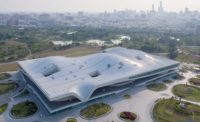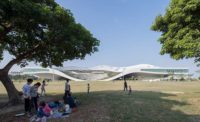Beijing, China
PTW Architects, CSCEC+Design, and Arup
They started with the idea of a box made of bubbles enveloping a set of swimming pools. The concept came quickly and earned everyone’s support. Figuring out how to make it work turned out to be more difficult. For three months in the spring of 2003, a team from the Australian architecture firm PTW, Arup, and China State Construction and Engineering (CSCEC) explored evolutionary biology, arcane 19th-century geometry, and the latest computer-modeling technology, racing against a competition deadline for the design of the National Swimming Center, the main venue for swimming events at the 2008 Olympics.
The team had already learned that Herzog & de Meuron’s bird’s-nest scheme was selected for the National Stadium next door. “We wanted to do something different from Herzog & de Meuron’s design,” recalls Tristram Carfrae, the leader of the Arup delegation. “Their’s was red and round, so our’s would be blue and boxy.” Since swimming pools need to be heated most of the year, the team figured that a greenhouse—a building that captures and holds solar energy—would be the most efficient structure for the job. That led to the notion of a continuous skin for the roof and walls, one that would be transparent or translucent. Glass wouldn’t be right, because its acoustics would create a din inside the building. So the team selected ethylene tetrafluoroethylene (ETFE), a transparent form of the plastic Teflon. In addition to being acoustically transparent, the material is lightweight and remarkably sturdy even at thicknesses as little as 0.008 inches (0.2 millimeters).
Looking at forms and patterns found in nature, the group started designing the skin. They quickly focused on soap bubbles and what happens to their geometry when they congregate. At first, the designers tried clustering cylinders to create a flat roof and walls, but weren’t happy with the gaps between the cylinders and the awkward shift from vertical cylinders (to support the roof) to horizontal ones (to support the walls). In their search for the most efficient way to divide space into cells of equal size with the least surface area between them, the designers explored solutions proposed in the 19th century by Belgian physicist Joseph Plateau and British mathematician William Thomson Kelvin, and by the Irish physicist Denis Weaire and his assistant Robert Phelan in the late 20th century. Eventually, the team adapted Weaire and Phelan’s ideas, developing a building skin made of cells with either 14 or 12 sides. “We wanted the bubble pattern to seem random, not repetitious,” explains Chris Bosse, who was one of the project architects for PTW and now runs his own firm in Sydney called the Laboratory for Visionary Architecture (LAVA). Using the Weaire-Phelan geometry, the group created a skin made of 4,000 ETFE bubbles, some as large as 30 feet across, with seven different sizes for the roof and 15 for the walls.
A space frame assembled on-site from 22,000 steel tubes welded to 12,000 nodes holds the cells in place and provides a column-free structure with spans of 396 feet in either direction. The three-dimensional frame is nondirectional—meaning it has no up or down, left or right—making it perfect for a high-seismic zone such as Beijing. The chemically treated water in the pools and the air pollution outside the building, though, are both corrosive. So the design team placed the steel frame inside a cavity made of two layers of ETFE pillows. For the roof, the cavity is 25 feet deep, and for the walls it is 12 feet.
Called the Water Cube (even though it’s a box 584 feet square and 102 feet high, not a cube), the rectangular design won over the competition jury. Completed early this year, the building seems to float on water, thanks to a reflecting pool surrounding it and a gentle cascade of water washing down its base and into the pool. Inside, the bubble theme continues with circles incised on the floor of the main lobby and a Bubble Lounge on the second floor where—you guessed it—champagne is served at bars made of smooth Corian dotted with circles.





Post a comment to this article
Report Abusive Comment